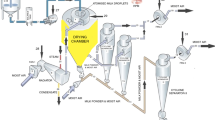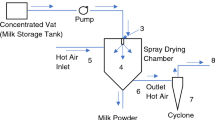Abstract
In order to avoid perishable characteristics and secure long shelf life of liquid milk, it is mostly converted into more stable derivatives such as butter, cheese, yogurt and milk powder. Amongst them, milk powder contains highest shelf life at ambient conditions and accounts for 76% of global annual trade of milk and milk derivatives. The milk powder production and its qualitative features are often characterized by huge amount of high- and low-grade energy requirements depending upon the number of stages employed for drying, e.g. single, two or three. In the present work, comparative thermodynamic analysis of two- and three-stage milk drying units has been executed. Both the units have been extensively explored on the grounds of parameters such as exergy efficiency (72.01%/43.67%), drying efficiency (67.50%/65.71%), drying chamber efficiency (57.77%/53.51%), exhaust air temperature (346.15 K/353.15 K), overall specific exergy destruction (3081.64 kJ/kg/5006.28 kJ/kg), overall specific exergy consumption (0.74 kWh/kg/1.34 kWh/kg) and sustainability indices (3.57/1.78) so as to establish the fact that the thermodynamic behaviour of two-stage spray dryer was far better than its three-stage counterpart, at the cost of slightly higher specific steam consumption (3.53 kg/kg/2.77 kg/kg).















Similar content being viewed by others
Change history
09 September 2021
A Correction to this paper has been published: https://doi.org/10.1007/s40430-021-03130-1
Abbreviations
- \(C_{p}\) (J/kg K):
-
Specific heat at constant pressure
- \(C_{pa}\) (J/kg K):
-
Specific heat of air
- \(C_{pv}\) (J/kg K):
-
Specific heat of vapour
- \(e_{a}\) (J/kg):
-
Specific energy of air
- \(E_{f,k}\) (W):
-
Energetic factor for kth component
- \(\dot{E}_{L,k}\) (W):
-
Energy loss for kth component
- \(\dot{E}_{{{\text{in}},k}}\) (W):
-
Input energy flow rate for kth component
- \(\dot{E}_{{{\text{IP}},k}}\) (W):
-
Energy improvement potential rate for kth component
- \(\dot{E}_{{{\text{out}},k}}\) (W):
-
Output energy flow rate for kth component
- \({\dot{\text{E}}\text{x}}\) (W):
-
Exergy rate
- \({\text{ex}}_{{{\text{ch}}}}\) (J/kg):
-
Chemical specific exergy
- \({\text{ex}}_{{{\text{ph}}}}\) (J/kg):
-
Physical specific exergy
- \({\dot{\text{E}}\text{x}}_{D,k}\) (W):
-
Exergy destruction rate for kth component
- \({\dot{\text{E}}\text{x}}_{{{\text{in}},k}}\) (W):
-
Input exergy flow rate for kth component
- \({\dot{\text{E}}\text{x}}_{{{\text{IP}}}}\) (W):
-
Exergy improvement potential rate for kth component
- \({\dot{\text{E}}\text{x}}_{{{\text{out}},k}}\) (W):
-
Output exergy flow rate for kth component
- \({\text{Ex}}_{f,k}\) (W):
-
Exergetic factor for kth component
- \(E_{\beta ,k}\) (W):
-
Relative irreversibility factor for kth component
- \(E_{\beta ,k}\) (W):
-
Relative energy destruction ratio for kth component
- \(h_{fg}\) (J/kg):
-
Latent heat of vaporization
- \(\dot{m}\) (kg/s):
-
Mass flow rate
- \(M_{a}\) (kg/mol):
-
Molecular mass of air
- \(M_{w}\) (kg/mol):
-
Molecular mass of water
- \(n\) :
-
Number of moles
- \(P\) (N/m2):
-
Pressure
- \(P_{0}\) (N/m2):
-
Ambient pressure
- \(R\) (J/mol K):
-
Universal gas constant
- \({\text{SI}}\) :
-
Sustainability index
- \(T\) (K):
-
Temperature
- \(T_{0}\) (K):
-
Ambient temperature
- \(v\)(m3/kg):
-
Specific volume
- \({\text{Vel}}_{a}\) (m/s):
-
Velocity of air
- \(x_{i}\) :
-
Mole fraction at ith state
- \(\omega\) (kg/kg):
-
Absolute humidity
- \(\omega_{s}\) (kg/kg):
-
Absolute humidity at saturated vapour pressure
- \(\eta_{k}\) (%):
-
Energy efficiency for kth component
- \(\eta_{P}\)(%):
-
Energy efficiency of plant
- \(\psi_{P}\)(%):
-
Exergy efficiency of plant
- \(\psi_{k}\)(%):
-
Exergy efficiency for kth component
- \(\varepsilon_{i}\) (kJ/mol):
-
Standard chemical exergy at ith state
- IFB:
-
Integrated fluidized bed
- MT:
-
Metric tonnes
- MF:
-
Milk fat
- MDP:
-
Madhu Dairy Plant
- SSSD:
-
Single-stage spray dryer
- TSSD:
-
Two-stage spray dryer
- THSSD:
-
Three-stage spray dryer
- TPD:
-
Tons per day
- VFB:
-
Vibro-fluidized bed
References
Focus S, America L (2020) “OECD-FAO Agricultural Outlook 2019-2028”, OECD Publishing, Paris/Food and Agriculture Organization of the United Nations, Rome. https://doi.org/https://doi.org/10.1787/agr_outlook-2019-enwww.fao.org/3/ca4076en/ca4076en.pdf[Accessed : 18, March 2020]
The Statistics Portal, UK, 2018. Available Fromhttps://www.statista.com/statistics/761219/india-milk-powder-production-volume/[Accessed : 18, February 2020]
N. Delhi, A. Aradhey, and M. Wallace. Dairy and Products Annual Report Highlights 2020.https://agriexchange.apeda.gov.in/marketreport/Reports/Dairy_and_Products_Annual_New_Delhi_India_10-15-2019.pdf[Accessed : 18, February 2020]
FAO, “Overview of global dairy market developments in 2018,” Dairy Market Review.https://www.fao.org/3/ca3879en/ca3879en.pdf[Accessed : 18, February 2020]
P. A. T. Scheme, “Widening the coverage of PAT Scheme Indian Dairy Industry 2013. https://shaktifoundation.in/wp-content/uploads/2017/06/widening-of-pat-sectors-dairy.pdf. [Accessed : 18, February 2020]
Zisopoulos FK, Rossier-Miranda FJ, Van der Goot AJ, Boom RM (2017) The use of exergetic indicators in the food industry–a review. Crit Rev Food Sci Nutr 57(1):197–211
Erbay Z, Koca N (2012) Energetic, exergetic, and exergoeconomic analyses of spray-drying process during white cheese powder production. Dry Technol 30(4):435–444
Erbay Z, Koca N (2014) Exergoeconomic performance assessment of a pilot-scale spray dryer using the specific exergy costing method. Biosys Eng 122:127–138
Erbay Z, Koca N (2012) Investigating the effects of operating conditions on the exergetic performance of a pilot–scale spray–drying system. Int J Exergy 11(3):302–321
Saygı G, Erbay Z, Koca N, Pazır F (2015) Energy and exergy analyses of spray drying of a fruit puree (cornelian cherry puree). Int J Exergy 16(3):315–336
Yildirim N, Genc S (2017) Energy and exergy analysis of a milk powder production system. Energy Convers Manag 149:698–705
Bühler F, Nguyen TV, Jensen JK, Holm FM, Elmegaard B (2018) Energy, exergy and advanced exergy analysis of a milk processing factory. Energy 162:576–592
Utlu Z, Hepbaşlı A (2014) Exergoeconomic analysis of energy utilization of drying process in a ceramic production. Appl Therm Eng 70(1):748–762
Khuenpet K, Charoenjarasrerk N, Jaijit S, Arayapoonpong S, Jittanit W (2016) Investigation of suitable spray drying conditions for sugarcane juice powder production with an energy consumption study. Agric Nat Resources 50(2):139–145
Atkins MJ, Walmsley MR, Neale JR (2011) Integrating heat recovery from milk powder spray dryer exhausts in the dairy industry. Appl Therm Eng 31(13):2101–2106
Patel SK, Bade MH (2019) Energy analysis and heat recovery opportunities in spray dryers applied for effluent management. Energy Convers Manag 186:597–609
Aghbashlo M, Mobli H, Rafiee S, Madadlou A (2012) Energy and exergy analyses of the spray drying process of fish oil microencapsulation. Biosys Eng 111(2):229–241
Aghbashlo M, Mobli H, Madadlou A, Rafiee S (2012) Influence of spray dryer parameters on exergetic performance of microencapsulation process. Int J Exergy 10(3):267–289
Soufiyan MM, Dadak A, Hosseini SS, Nasiri F, Dowlati M, Tahmasebi M, Aghbashlo M (2016) Comprehensive exergy analysis of a commercial tomato paste plant with a double-effect evaporator. Energy 111:910–922
Balkan F, Colak N, Hepbasli A (2005) Performance evaluation of a triple-effect evaporator with forward feed using exergy analysis. Int J Energy Res 29(5):455–470
Sogut Z, Ilten N, Oktay ZUHAL (2010) Energetic and exergetic performance evaluation of the quadruple-effect evaporator unit in tomato paste production. Energy 35(9):3821–3826
Singh G, Singh PJ, Tyagi VV, Barnwal P, Pandey AK (2019) Energy, exergy and exergoeconomic analysis of high temperature short time milk pasteurisation plant. Int J Exergy 30(1):26–62
Singh G, Singh PJ, Tyagi VV, Barnwal P, Pandey AK (2019) Exergy and thermoeconomic analysis of cream pasteurisation plant. J Therm Anal Calorim 137(4):1381–1400
Singh G, Singh PJ, Tyagi VV, Barnwal P, Pandey AK (2019) Exergy and thermo-economic analysis of ghee production plant in dairy industry. Energy 167:602–618
Singh G, Singh PJ, Tyagi VV, Pandey AK (2019) Thermal and exergoeconomic analysis of a dairy food processing plant. J Therm Anal Calorim 136(3):1365–1382
Soufiyan MM, Aghbashlo M (2017) Application of exergy analysis to the dairy industry: a case study of yogurt drink production plant. Food Bioprod Process 101:118–131
Soufiyan MM, Aghbashlo M, Mobli H (2017) Exergetic performance assessment of a long-life milk processing plant: a comprehensive survey. J Clean Prod 140:590–607
Jokandan MJ, Aghbashlo M, Mohtasebi SS (2015) Comprehensive exergy analysis of an industrial-scale yogurt production plant. Energy 93:1832–1851
Nasiri F, Aghbashlo M, Rafiee S (2017) Exergy analysis of an industrial-scale ultrafiltrated (UF) cheese production plant: a detailed survey. Heat Mass Transf 53(2):407–424
Dowlati M, Aghbashlo M, Soufiyan MM (2017) Exergetic performance analysis of an ice-cream manufacturing plant: a comprehensive survey. Energy 123:445–459
Garg A, Sharma MP, Sharma V (2016) Exergy and energy analyses of a sugarcane juice production and clarification unit. Int J Exergy 19(1):78–90
van der Goot AJ, Pelgrom PJ, Berghout JA, Geerts ME, Jankowiak L, Hardt NA, Keijer J, Schutyser MA, Nikiforidis CV, Boom RM (2016) Concepts for further sustainable production of foods. J Food Eng 168:42–51
Friso D, Bortolini L, Tono F (2020) Exergetic analysis and exergy loss reduction in the milk pasteurization for Italian cheese production. Energies 13(3):750
Samarin GN, Vasilyev AN, Normov DA, Eventeva EA, Mamahay AK (2020, March) Energy efficiency increase of the initial milk processing. In: IOP Conference Series: Materials Science and Engineering (Vol. 791, No. 1, p. 012072). IOP Publishing
Feil AA, Schreiber D, Haetinger C, Haberkamp ÂM, Kist JI, Rempel C, Maehler AE, Gomes MC, da Silva GR (2020) Sustainability in the dairy industry: a systematic literature review. Environ Sci Pollut Res 27:33527–33542
Reichler SJ, Murphy SI, Erickson AW, Martin NH, Snyder AB, Wiedmann M (2020) Interventions designed to control postpasteurization contamination in high-temperature, short-time-pasteurized fluid milk processing facilities: a case study on the effect of employee training, clean-in-place chemical modification, and preventive maintenance programs. J Dairy Sci 103(8):7569–7584
Camci M (2020) Thermodynamic analysis of a novel integration of a spray dryer and solar collectors: a case study of a milk powder drying system. Dry Technol 38(3):350–360
Wincy WB, Edwin M, Sekhar SJ (2020) Energy and exergy evaluation of rice processing mills working with biomass gasifier in parboiling process. Fuel 259:116255
Srinivasan B, Pal J, Srinivasan R (2018) Enhancement of energy efficiency at an Indian milk processing plant using exergy analysis. In: Sustainable energy technology and policies. Springer, Singapore, pp 425–450
Johnson P (2020) Energy and exergy analysis in spray drying systems. PhD Thesis, The University of Sydney, Australia
Dincer I, Rosen MA (1999) Energy, environment and sustainable development. Appl Energy 64(1–4):427–440
Dinçer İ, Zamfirescu C (2016) Drying phenomena: theory and applications. John Wiley & Sons
Ren CQ, Tang GF, Li NP, Zhang GF, Yang J (2001) Analysis of exergy of moist air and energy saving potential in HVAC by evaporative cooling energy recovery. Int J Archit Sci 2(4):113–117
Atmaca A, Yumrutaş R (2014) Thermodynamic and exergoeconomic analysis of a cement plant: part I-Methodology. Energy Convers Manag 79:790–798
Holman JP (2001) Analysis of experimental data. In: Holman JP (ed) Experimental methods for engineers. McGraw-Hill, Singapore, pp 48–143
Singh G, Chopra K, Tyagi VV, Pandey AK, Ma Z, Ren H (2021) A comprehensive energy, exergy and enviroeconomic (3-E) analysis with carbon mitigation for multistage evaporation assisted milk powder production unit. Sustain Energy Technol Assess 43:100925
G. E. A. P. Engineering, “Milk Powder Technology Evaporation and Spray Drying”, GEA Niro, Copenhagen, 2010. https://www.gea.com/en/binaries/Milk%20Powder%20Technology%20%20 Evaporation%20and%20Spray%20Drying_tcm11–33784.pdf[Accessed : 18, March 2020]
Woo MW, Majumdar AS, Daud WRW (2016) Spray drying technology. National University of Singapore, Singapore
Acknowledgements
The authors would like appreciate the technical-cum-non-technical assistance extended to us by the authorities of National Dairy Research Institute (NDRI, Karnal) and Madhu Dairy Plant (MDP, Pehowa), Haryana (India), throughout the assessment phase in order to accomplish the titled objectives.
Author information
Authors and Affiliations
Corresponding author
Additional information
Technical Editor: Monica Carvalho.
Publisher's Note
Springer Nature remains neutral with regard to jurisdictional claims in published maps and institutional affiliations.
The online version of this article was revised as the affiliations of authors in the author group are mismatched.
Rights and permissions
About this article
Cite this article
Singh, G., Tyagi, V.V., Chopra, K. et al. Energetic and exergetic assessment of two- and three-stage spray drying units for milk processing industry. J Braz. Soc. Mech. Sci. Eng. 43, 359 (2021). https://doi.org/10.1007/s40430-021-03015-3
Received:
Accepted:
Published:
DOI: https://doi.org/10.1007/s40430-021-03015-3




